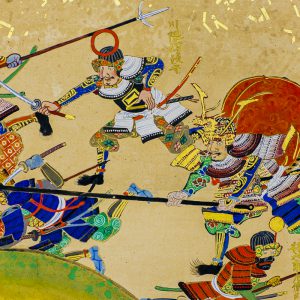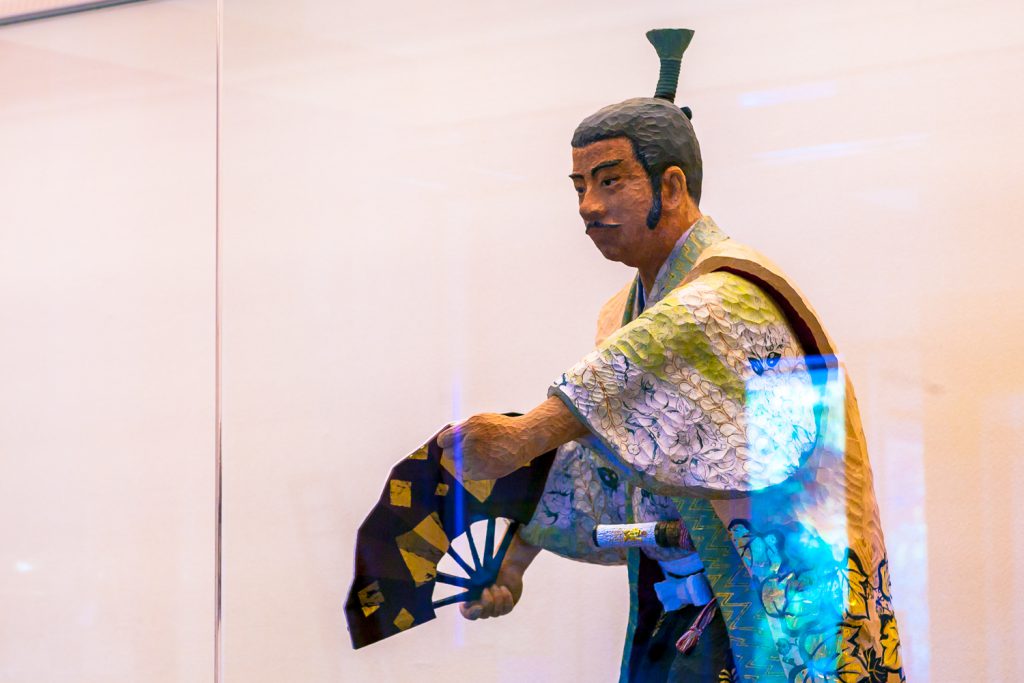A historical museum that introduces the life and legacy of Mogami Yoshiaki, daimyo of Yamagata prefecture during the Sengoku period.
Mogami Yoshiaki Historical Museum , Guide to Lobby Area

This museum opened in 1989 to commemorate the 100th anniversary of the founding of the modern city of Yamagata on December 1, 1889. It focuses on Yoshiaki Mogami, a daimyo and hero of the Yamagata region who lived in 16th – 17th centuries, as well as the history and cultural heritage of this region.
First, we will tell you the outline of Sir Yoshiaki Mogami. The Mogami Family was the lord of Yamagata since the 14th Century, and its 11th lord was Yoshiaki. He was active from later half of the 16th Century to the beginning of the 17th Century. That time was transition from the Sengoku Era, namely the civil war era, to the unified country under the Edo Shogunate.

Concierge / 最上義光サポータークラブ義光会
Mogami Yoshiaki was the feudal lord of Yamagata some 450 years ago during the Sengoku period. Viewers of the popular NHK historical drama series Dokuganryu ("One-Eyed Dragon") Masamune will know Yoshiaki as the uncle of the powerful daimyo Date Masamune. While Yoshiaki was portrayed as a villain in this drama series, he was in fact a peace-loving leader who worked to improve the lives of the people in his domain, and a man of great culture and refinement. Yoshiaki also laid the foundations for the Yamagata of today by building Yamagata Castle and improving the castle town of Yamagata, which would eventually develop into present-day Yamagata city, while at the same time encouraging the growth of new industries. This historical museum exhibits materials relating to Mogami Yoshiaki and the Mogami clan, as well as cultural artifacts of the Yamagata region.
 osusume en
osusume en
-
CP.No.01 Artifacts Unearthed at Yamagata Castle Site
This exhibit displays items unearthed during archaeological excavations of the Yamagata Castle premises. Yamagata Castle was first built in 1357 by Shiba Kaneyori, founder of the Mogami clan. It was approximately 250 years later that Mogami Yoshiaki constructed a much larger and grander castle befitting a great leader of his stature, and established the surrounding castle town. However, when castles throughout Japan were dismantled after the passage of the Castle Abolishment Law of 1873, the moats of Yamagata Castle, with the exception of the second moat, were also filled in. An ongoing excavation at the site of the former castle has unearthed artifacts including the roof tiles, rusted iron nails, and pottery fragments exhibited here. The shachi-gawara (tiles in the shape of a mythical fish) would have been mounted at both ends of a castle roof in the belief that they would provide protection from fire.
-
CP.No.02 16th –17th Century Map of Yamagata Castle Town
This map shows the castle town of Yamagata as it existed approximately 400 years ago. The central red-shaded part indicates the area occupied by the feudal lord. The three belt-like blue rings encircling this area represent the three moats which protected the feudal lord from enemy attack. The land located within these three moats constitutes the Yamagata Castle premises, an area which had a circumference of 6.5 kilo meters and occupied 2,3 square kilo meters of land. The blue line crossing the map from the upper left corner indicates a river that was also used as a defensive barrier against enemies. Outside the castle premises, squares containing names written in Chinese characters designate the residences of samurai who served the feudal lord as retainers and vassals, with peach-shaded squares showing the location of religious establishments. The area of the map partitioned off by red lines indicates the residential area occupied by craftsmen and merchants. The layout of the modern city of Yamagata has its origins in the arrangement of this castle town that was established over four centuries ago.
-
CP.No.03 Wooden Statues of Komahime, Mogami Yoshiaki
These carved and painted camphor wood statues of Mogami Yoshiaki and his second daughter Komahime (Princess Koma) were commissioned for the opening of the Mogami Yoshiaki Historical Museum in 1989. The artist, Akuo Nagahashi (1928-2000), was a sculptor born in Yamagata city. His statue of Princess Koma represents the princess in the final moments before her execution, and Yoshiaki is portrayed in the midst of a dance that symbolizes the grief-stricken father “sending” his daughter off on her final journey. Behind them are a set of decorative sliding doors that were used in Yamagata Castle in the 18th century.
-
CP.No.04 The Tragic Story of Princess Koma
Princess Koma (Komahime), Yoshiaki’s second daughter, was reputed to be the most beautiful woman in Eastern Japan. Hearing rumors of her loveliness, Toyotomi Hidetsugu, nephew of the powerful dictator Toyotomi Hideyoshi, requested that Komahime be given to him as a concubine. Although Yoshiaki denied this request numerous times, in the end he found himself unable to refuse any longer, and reluctantly sent his daughter to Hidetsugu in Kyoto. Tragically, it was only shortly after Komahime’s arrival that friction erupted between members of the ruling class, with Hidetsugu accused of treasonous acts and ordered to commit ritual suicide. The execution of Hidetsugu’s entire family was ordered as well, and thus it was that Komahime, not even yet officially recognized as a concubine of Hidetsugu, was beheaded at the age of 15. Yoshiaki was said to be so overwhelmed by grief that he could not eat or drink, and the people of the Yamagata region continue to remember Komahime as the ill-fated princess whose death was brought about by her youth and beauty. Komahime can certainly be said to be a tragic example of the Japanese proverb bijin-hakumei, or “beauty and good fortune seldom go hand in hand”.
-
CP.No.05 The ‘Death Poem’ of Princess Koma (replica)
Princess Koma (1581-1595) was Yoshiaki’s second daughter. Reputed to be the most beautiful woman in Eastern Japan, Princess Koma became the concubine of Toyotomi Hidetsugu, regent to the Emperor, at age 15. However, it was only shortly afterwards that Hidetsugu was suspected of treason and ordered to commit suicide, and Princess Koma was executed along with the rest of Hidetsugu’s family at Sanjōgawara in Kyoto. Composed by Princess Koma before her death, this ‘death poem’ was set down on paper by the priest who performed her memorial service and is said to be framed in a piece of a kimono of the same era. The original poem is located at the Zuisen-ji Temple in Kyoto.
information
Address:1-53 Ote-machi, Yamagata-shi
Phone number:023-625-7101
Open hour:9 a.m. – 5 p.m. (admission until 4:30)
Free admission
Closed Mondays (or Tuesdays if Monday is a national holiday) and during the New Year holidays. May also close for exhibition changes or other reasons.
 to go
to go
-

Yamagata University Museum / 山形大学附属博物館
-

Heisenji Temple, Dainichido Hall / 平泉寺大日堂
-

Mogami Yoshiaki Historical Museum, Guide to Second Exhibition Room
-

Yamagata City Local History Museum (former Saiseikan Hospital) / 山形市郷土館【旧済生館本館】
-

Yamagata Museum of Art / 山形美術館
-

Mogami Yoshiaki Historical Museum, Guide to First Exhibition Room
-

Yamagata Prefectural Museum / 山形県立博物館
-

Bunshokan, Yamagata Prefecture Local Museum / 山形県郷土館 【文翔館】
-

Heisenji Temple / 平泉寺
-

Yamagata Prefectural Museum Educational Resources Museum / 山形県立博物館教育資料館






